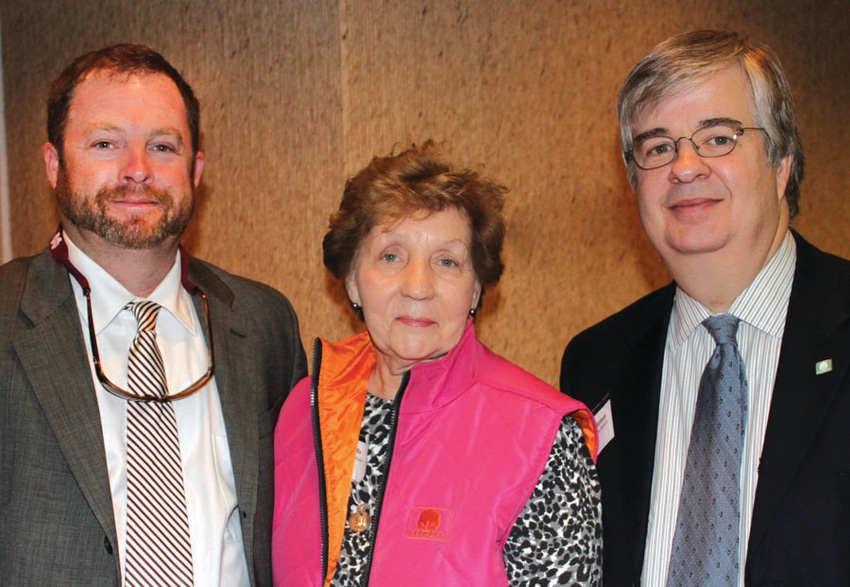
As a result of the research and promotion efforts of Cotton Incorporated, “More consumers believe cotton and cotton blends are best suited for today’s fashions than another fabric," says Bill Gillon, president and CEO of the Cotton Board. "Natural fibers, such as cotton, are perceived as being of a better quality than non-natural fibers. Ninety percent of consumers believe cotton is safe for the environment, and significantly, you own one of the most trusted, widely respected, and well-known brands in the world: the Seal of Cotton. ”

The dollars that American cotton producers and importers invest in the Cotton Research and Promotion Program continue to produce “a fine report card,” says Bill Gillon, president and chief executive officer of the Cotton Board at Memphis.
Since the establishment of the checkoff program in 1966, the continuing vision of cotton producers and industry leaders has kept cotton “an economic fixture in the U.S., helping provide an economic return to their families and communities,” he said at the Mississippi Farm Bureau Federation Commodity Conference.
Today, as a result of the research and promotion efforts of Cotton Incorporated, Gillon says, “More consumers believe cotton and cotton blends are best suited for today’s fashions than another fabric. Natural fibers, such as cotton, are perceived as being of a better quality than non-natural fibers.
“Ninety percent of consumers believe cotton is safe for the environment, and significantly, you own one of the most trusted, widely respected, and well-known brands in the world: the Seal of Cotton. ”
And, he says, an economic analysis by Texas A&M and Texas Tech Universities, has shown that every $1 invested by producers in the checkoff program generates a return of almost $9, and for every $1 invested by importers there is a $15 return.
In the research arena, Gillon notes, Cotton Incorporated has been in the forefront of new techniques and technology to improve cotton production, cotton uses, and cotton marketing, including the cotton module builder, the Engineered Fiber Selection System, wrinkle-resistant technology, the Engineered Knit program, EasiFlo Cottonseed, Tough Cotton durable press technology, and a host of developments to assist world textile mills in a more effective, efficient use of cotton.
Cotton Incorporated also developed one of the world’s most effective marketing campaigns, “The Fabric of Our Lives,” which has helped not only to boost sales of cotton products, but to create an image in consumers’ minds that cotton represents superior quality and sustainability.
“The vision of cotton industry leaders in the 1950s and 1960s — at a time when the industry was in serious decline and man-made fiber manufacturers were pouring tens of millions of dollars into research and promotion of polyester, Dacron, and other fibers — created the Research and Promotion program that gave our industry a second life, and has continued opening new doors for cotton and its products,” Gillon says.
Challenges and opportunities
The leaders guiding today’s program and investing checkoff dollars “are forward-thinking individuals, who are anticipating upcoming challenges and opportunities for our industry.”
As an example of recent challenges, he cites the performance apparel company, Under Armour, which had dubbed “cotton as the enemy,” but when they introduced a new line of Charged-Cotton apparel based on research by Cotton Incorporated, “consumers flocked to their products and they posted amazing revenue gains. Thanks to Cotton Incorporated, cotton is now a major player in the performance apparel market.”
On another front, last November, Gillon says, the Heritage Foundation, a Washington think tank, “started a firestorm when they opposed what they dubbed ‘Obama’s Christmas tree tax.’
“When it was pointed out that there was no tax — just an effort by Christmas tree growers to compete with imported, artificial trees through a new research and promotion program — the attack spread to all other checkoff programs, with the argument that government/private partnerships don’t work and should never be supported.
“Within two weeks a senator from South Carolina, which produces a significant amount of cotton, introduced an amendment to eliminate all research and promotion programs — and the cotton program was first on the list.”
It was “sad,” Gillon says, that what cotton industry leaders worked so hard to construct could “so quickly and foolishly be thrown on the trash heap in the name of political expediency.
“I was taught not to throw out the baby with the bath water, and I’m concerned when politicians argue forcefully to overnight throw away strong, successful programs like the Cotton Research and Promotion Program, which is a model of effectiveness.”
The program “has given back economic returns many times over” from the dollars invested, Gillon says.
“I encourage everyone in the industry to remain sensitive to the vision that led to the creation of this and other checkoff programs, and to remain involved in your local cotton organizations so you can take advantage of your ownership of this program and help to steer the course for cotton.
“We should never forget what it took to get us here. We should be diligent and honest about the challenges we face, and we should continue to work collectively and cooperatively to secure our industry’s future.”
About the Author(s)
You May Also Like



